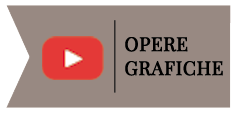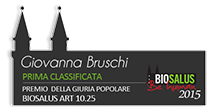GIOVANNI ZAVARELLA – 29/12/1997
The aesthetic and referential outcome of the etchings (let’s not mention aquatints!) and the drawings by Giovanna Bruschi resorts to the merging of erstwhile cultural considerations deriving from a futurist background and the influence of masters such as G. Dottori, P. Parigi and P. Donati, who inspired the simultaneity of motion no longer rendered as a ‘frozen instant within a universal dynamism’ but as a ‘dynamic and eternal sensation as such’. Bruschi’s artistic experience is not the result of an accidental nor incidental casual encounter with figurativism; on the contrary, it is the natural development of a number of themes: a spontaneous propensity for a rigorous spirituality, an inner need for innovation, an intellectual vital self awakening, as well as an academic acculturation, and a sublime emergence of the human soul in search of beauty. All these incentives offer Bruschi the perfect sailing vessel and the solid bedrock where to rest, as a seagull, her tired wings in the attempt to fly beyond the horizon of mediocrity, the fossilized elementary renditions of landscaping, the emptiness of hyperrealism and the banality of sweet, naive and ornamental images so captivating to popular culture. The pencil and the burin are Bruschi’s technical-linguistic tools by virtue of which the Perugian artist conjures up the emergence of essential images, in a sort of perennial figurative subtle blending of shades, connected along imaginary paths, as if within the framework of fantastic galaxies, where lines, points, incisions and recurring circles, rise in a transcendental thrust through masses and harmonies of light and shadow and metaphysical figures (never instrumental) such as the sun, the source of truth and existence. Bruschi draws backgrounds charged with a network of lines and dots, geometric abstractions and formidable symmetrical relationships, enchanted suspended atmospheres, resembling sculptures transformed by the light into poetic ambiances, populated by timeless fairy-tale presences with a lyric continuity with the past. As in a fabric woven by symbols, the artist elaborates the generating matrix that contains a natural order beyond matter; it is a poignant and vibrant art that is facing the abyss of conscience, dreams and religious truths. It is also a “genetic” code which is part of an infinite variety of universal laws and which highlights the contemplative mind, the true expression of visual perception.
By means of a duality of lights and shadows – not necessarily a dualism – Bruschi rejects basic chromatic and elementary tonal minimalim, while adopting a complex and harsh path in black and white, yet a harbinger of exhilarating gratifications. The compositional structure displays a fairy-tale world made of rocks, an imaginary enchanted stone forest, a virtual reality alien to the eye but engraved, with indelible characters, and implanted in our senses, generating an intense emotion. The result is a formal beauty composed (and decomposed) into a unity where form and content merge into the principle of cause and effect, developing in each of us a strong emotional reaction, the same feeling experienced by a pilgrim across a valley of tears. It would not be wrong to to assume that the religious exhilaration embodied by the artist with her abstractions and religious symbolism arises not for aestheticism as an end in itself, but as a priority requirement for the mental energy needed to create beauty from the cerebral “magma” in the manner of the art pour l’art, where the départ implication aims to visualize the recurrent miracle, in the rational man of the cogito ergo sum. The internalized figuration is reworked in a finite context that expands towards infinity, as if galaxies would chase each other playing hide-and-seek with the artist trying to catch them with her fervid imagination. This is an attempt to contain the divine element in a material grid made from an ornamental geometrical and scientific form, the same formula that marked the signature of the Renaissance with the undeclared objective of unity of science, conscience and knowledge. These are the formulas employed by Bruschi while embodying in her work the visionary delusions of the dream and the joy of the vigorous and positive energy of life. Furthermore, these are also the images of the delirium of a tide that sweeps across with melodies that produce a creative process, similar to that of the sculptor, by removing matter from a primitive galactic chaos. Similarly, our artist reveals a series of intriguing and joyful poetic images that run after each other in merriment, not so much as an exclusive result for those who created them, but as a memory of eternal time while offering themselves generously and immeasurably to those who have a yearning for poetic beauty and poetry of the image. In her second, but not last, season of her artistic life, Bruschi has enriched this poetry with the sacred images of Christianity, such as salvific mystification of Christ, nailed by the ignorance of mankind on the mountain of Golgotha and the maternal love of the female figure of the Madonna, the Mother as the prevailing icon of rare beauty that coincides with Mary, the Mother of Jesus. Bruschi depicts profound expressiveness in Angela of Foligno’s features, while the Saint is meditating, with supreme joy the love of God the creator. She achieves this effect by providing a clever distribution of black and white, light and shadow, and softened facial features wrapped in clouds of veiled drapery.The artist’s pencil does not seem to be just an instrument of mediation between the creator and creation, or between the incarnate and the uncreated; indeed, the pencil is the faithful executor of a pre-existing idea, unfiltered, from/to the author’s mind and a luminous mystery that embodies a joy that borders with the extraordinary outcome of great artistic depth and great emotional effect. This exceptional beauty is inherited from a classical legacy that does not interfere with with contemporary futurism, but it actually manages to inspire in the beholder a cathartic effect of beauty and fear through the use of controlled glimpses of light that leaves the observer with a kind of a bouche bèe feeling of wonder with eyes fixed on the mystery of those who know how to love expecting nothing in return.
It would not be presumptuous to assume that Giovanna Bruschi deserves a special value analysis of her work, artistic respect, critical consideration, and above all greater exposure and visibility. Without the need to use any Captatio Benevolentiae, or lavish praise, it is however a real shame that her oeuvre does not receive the proper public exposure for further study or for the enjoyment of art lovers.





